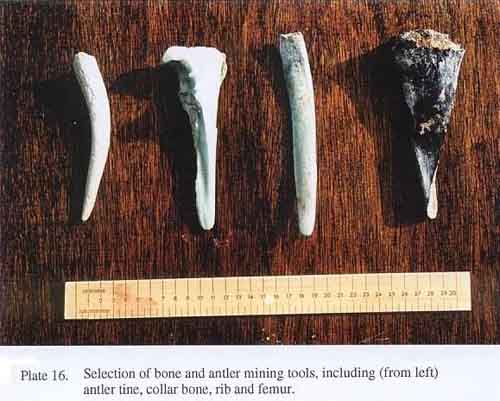

Since the beginning of civilization, people have used stone, ceramics and, later, metals found on or close to the EarthÕs surface. These were used to manufacture early tools and weapons, for example, high quality flint found in northern France and southern England were used to create flint tools. Flint mines have been found in chalk areas where seams of the stone were followed underground by shafts and galleries.
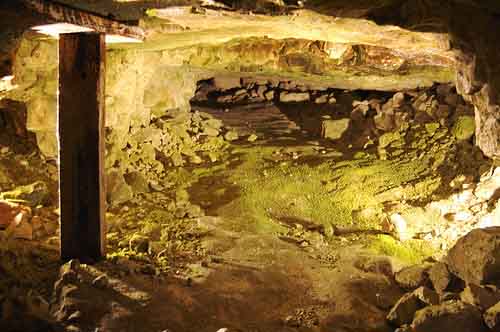
The mines at Grimes Graves are especially famous, and like most other flint mines, are Neolithic in origin (ca 4000 BC-ca 3000 BC). Other hard rocks mined or collected for axes included the greenstone of the Langdale axe industry based in the English Lake District.
The oldest known mine on archaeological record is the Lion Cave in Swaziland. At this site, which by radiocarbon dating proves the mine to be about 43,000 years old, paleolithic humans mined mineral hematite, which contained iron and was ground to produce the red pigment ochre. Mines of a similar age in Hungary are believed to be sites where Neanderthals may have mined flint for weapons and tools.

Ancient Egyptians mined malachite at Maadi. At first, Egyptians used the bright green malachite stones for ornamentations and pottery. Later, between 2,613 and 2,494 BC, large building projects required expeditions abroad to the area of Wadi Maghara in order to secure minerals and other resources not available in Egypt itself. Quarries for turquoise and copper were also found at Wadi Hamamat, Tura, Aswan and various other Nubian sites on the Sinai Peninsula and at Timna.

Mining in Egypt occurred in the earliest dynasties, and the gold mines of Nubia were among the largest and most extensive of any in Ancient Egypt, and are described by the Greek author Diodorus Siculus. He mentions that fire-setting was one method used to break down the hard rock holding the gold. One of the complexes is shown in one of earliest known maps. They crushed the ore and ground it to a fine powder before washing the powder for the gold dust.

The Romans used hydraulic mining methods on a large scale to prospect for the veins of ore, especially a now obsolete form of mining known as hushing. It involved building numerous aqueducts to supply water to the minehead where it was stored in large reservoirs and tanks. When a full tank was opened, the wave of water sluiced away the overburden to expose the bedrock underneath and any gold veins. The rock was then attacked by fire-setting to heat the rock, which would be quenched with a stream of water. The thermal shock cracked the rock, enabling it to be removed, aided by further streams of water from the overhead tanks. They used similar methods to work cassiterite deposits in Cornwall and lead ore in the Pennines.
The methods had been developed by the Romans in Spain in 25 AD to exploit large alluvial gold deposits, the largest site being at Las Medulas, where seven long aqueducts were built to tap local rivers and to sluice the deposits. Spain was one of the most important mining regions, but all regions of the Roman Empire were exploited. They used reverse overshot water-wheels for dewatering their deep mines such as those at Rio Tinto. In Great Britain the natives had mined minerals for millennia , but when the Romans came, the scale of the operations changed dramatically.
The Romans needed what Britain possessed, especially gold, silver, tin and lead. Roman techniques were not limited to surface mining. They followed the ore veins underground once opencast mining was no longer feasible. At Dolaucothi they stoped out the veins, and drove adits through barren rock to drain the stopes. The same adits were also used to ventilate the workings, especially important when fire-setting was used.
At other parts of the site, they penetrated the water table and dewatered the mines using several kinds of machine, especially reverse overshot water-wheels. These were used extensively in the copper mines at Rio Tinto in Spain, where one sequence comprised 16 such wheels arranged in pairs, and lifting water about 80 feet (24 m). They were worked as treadmills with miners standing on the top slats. Many examples of such devices have been found in old Roman mines and some examples are now preserved in the British Museum and the National Museum of Wales.
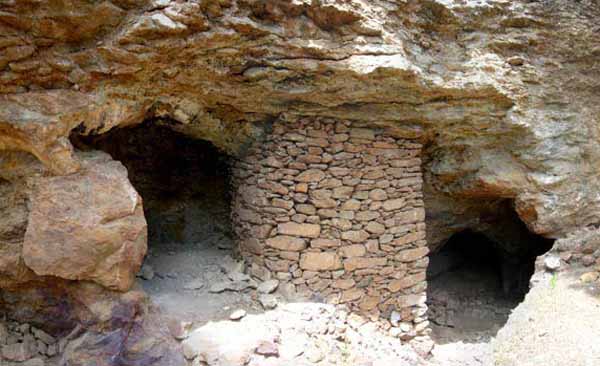
Mining in Europe has a very long history, examples including the silver mines of Laurium, which helped support the Greek city state of Athens. However, it is the Romans who developed large scale mining methods, especially the use of large volumes of water brought to the minehead by numerous aqueducts. The water was used for a variety of purposes, including using it to remove overburden and rock debris, called hydraulic mining, as well as washing comminuted or crushed ores, and driving simple machinery.
Mining as an industry underwent dramatic changes in medieval Europe. The mining industry in the early Middle Ages was mainly focused on the extraction of copper and iron. Other precious metals were also used mainly for gilding or coinage. Initially, many metals were obtained through open-pit mining, and ore was primarily extracted from shallow depths, rather than though the digging of deep mine shafts. Around the 14th century, the demand for weapons, armor, stirrups, and horseshoes greatly increased the demand for iron. Medieval knights for example were often laden with up to 100 pounds of plate or chain link armor in addition to swords, lances and other weapons. The overwhelming dependency on iron for military purposes helped to spur increased iron production and extraction processes.
These new military applications coincided with a population explosion throughout Europe in the 11th-14th centuries which enriched the demand for precious metals in order to fill a currency shortage. The silver crisis of 1465 occurred when the mines had all reached depths at which the shafts could no longer be pumped dry with the available technology. Although the increased use of bank notes and the use of credit during this period did decrease the dependence and value of precious metals, these forms of currency still remained vital to the story of medieval mining. Use of water power in the form of water mills was extensive; they were employed in crushing ore, raising ore from shafts and ventilating galleries by powering giant bellows.
Black powder was first used in mining in Selmecbanya, Kingdom of Hungary (present-day Banska Stiavnica, Slovakia) in 1627. Black powder allowed blasting of rock and earth to loosen and reveal ore veins, which was much faster than fire-setting, in which rock was exposed to heat and then doused with cold water. Black powder allowed the mining of previously impenetrable metals and ores. In 1762, the worldÕs first mining academy was established in the same town.
The widespread adoption of agricultural innovations such as the iron plowshare, as well as the growing use of metal as a building material, was also a driving force in the tremendous growth of the iron industry during this period. Inventions like the arrastra were often used by the Spanish to pulverize ore after being mined. This device employed animal power and utilized mechanical principles similar to that of the ancient Middle Eastern technology of grain threshing.

Much of our knowledge of Medieval mining techniques comes from books such as Biringuccio's De la pirotechnia and probably most importantly from Georg Agricola's De re metallica (1556). These books detail many different mining methods used in German and Saxon mines. One of the prime issues confronting medieval miners (and one which Agricola explains in detail) was the removal of water from mining shafts. As miners dug deeper to access new veins, flooding became a very real obstacle. As a result the mining industry became dramatically more efficient and prosperous as the use of various mechanical and animal driven pump systems were implemented.

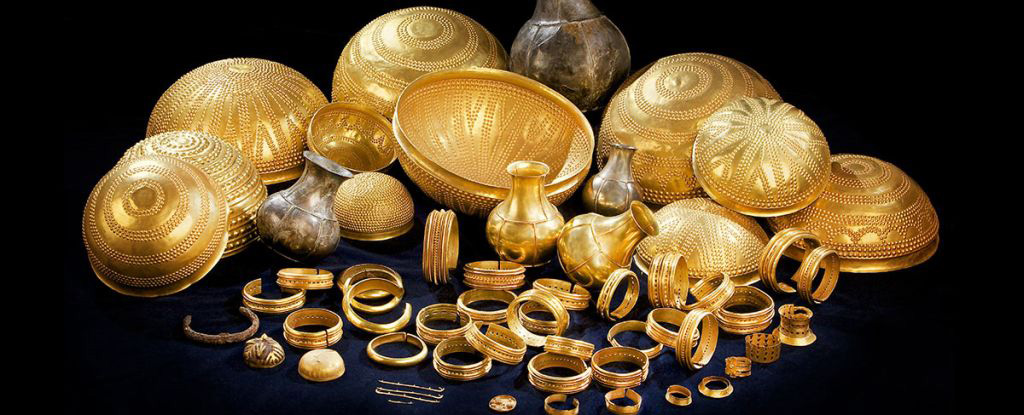
Strange Metal From A Meteor Beyond Our World Found in Ancient Treasure Stash Science Alert - February 23, 2024
There's a number of pre-Iron Age iron artifacts around the world that were forged from the stuff of meteorites. Perhaps most famous is the meteoritic iron dagger of Pharaoh Tutankhamun, but there are other Bronze Age weapons made of the material, and they were very highly prized. Amidst a cache of glittering golden treasures from the Iberian Bronze Age, a pair of corroded objects might be the most precious of all.
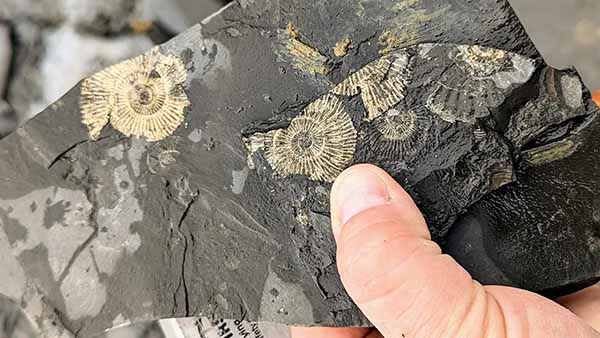
Beautiful Golden Fossils Reveal Process Of Fossilization 183 Million Years Ago IFL Science - May 3, 2023
The Posidonia Shale in southwest Germany is the source of many of these golden-hued fossils, particularly those of soft-bodied sea life such as squid and ichthyosaur embryos that were around in the early Jurassic. These geological deposits containing soft-bodied preserves are known as Konservat-Lagerstatten and are extremely rare. Previously it was thought that anoxic conditions helped to fossilize these specimens. While pyrite, also known as fool's gold, was thought to be the source of this shine, a closer inspection has revealed more about the conditions in which these fossils were formed.
In North America there are ancient, prehistoric copper mines along Lake Superior. Indians availed themselves of this copper starting at least 5000 years ago, and copper tools, arrowheads, and other artifacts that were part of an extensive native trade network have been discovered. In addition, obsidian, flint, and other minerals were mined, worked, and traded. While the early French explorers that encountered the sites made no use of the metals due to the difficulties in transporting it, the copper was eventually traded throughout the continent along major river routes. In Manitoba, Canada, there also are ancient quartz mines near Waddy Lake and surrounding regions.
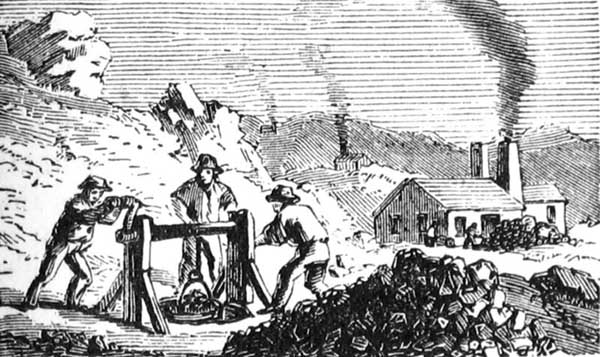
In the early colonial history of the Americas, native gold and silver was quickly expropriated and sent back to Spain in fleets of gold- and silver-laden galleons mostly from mines in Central and South America. Turquoise dated at 700 A.D. was mined in pre-Columbian America; in the Cerillos Mining District in New Mexico, estimates are that about 15,000 tons of rock had been removed from Mt. Chalchihuitl using stone tools before 1700.
Mining in the United States became prevalent in the 19th century, and the General Mining Act of 1872 was passed to encourage mining of federal lands. As with the California Gold Rush in the mid 19th century, mining for minerals and precious metals, along with ranching, was a driving factor in the Westward Expansion to the Pacific coast. With the exploration of the West, mining camps were established and expressed a distinctive spirit, an enduring legacy to the new nation; Gold Rushers would experience the same problems as the Land Rushers of the transient West that preceded them. Aided by railroads, many traveled West for work opportunities in mining. Western cities such as Denver and Sacramento originated as mining towns. Prehistoric Mining

Archaeologists uncover oldest mine in the Americas PhysOrg - May 19, 2011
Archaeologists have discovered a 12,000-year-old iron oxide mine in Chile that marks the oldest evidence of organized mining ever found in the Americas, according to a report in the June issue of Current Anthropology. A team of researchers led by Diego Salazar of the Universidad de Chile found the 40 meter trench near the coastal town of Taltal in northern Chile. It was dug by the Huentelauquen people - the first settlers in the region - who used iron oxide as pigment for painted stone and bone instruments, and probably also for clothing and body paint, the researchers say.
The remarkable duration and extent of the operation illustrate the surprising cultural complexity of these ancient people. "It shows that mining was a labor-intensive activity demanding specific technical skills and some level of social cooperation transmitted through generations," Salazar and his team write.
An estimated 700 cubic meters and 2,000 tons of rock were extracted from the mine. Carbon dates for charcoal and shells found in the mine suggest it was used continuously from around 12,000 years ago to 10,500 years ago, and then used again around 4,300 years ago. The researchers also found more than 500 hammerstones dating back to the earliest use of the mine.
ANCIENT AND LOST CIVILIZATIONS